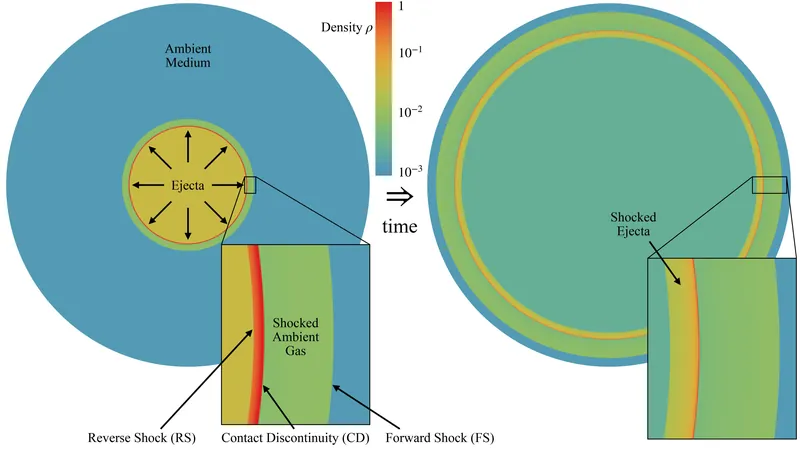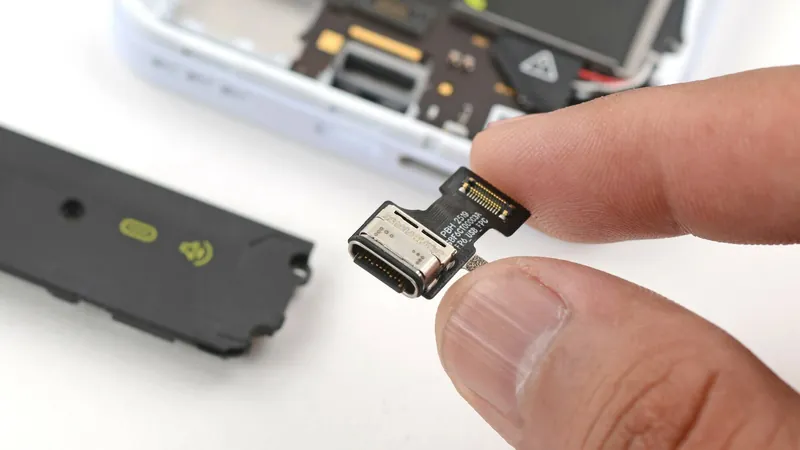
Astronomers Unveil Groundbreaking Technique to Decode Cosmic Explosions!
2024-10-29
Author: Sarah
Astrophysical Breakthroughs in Cosmic Explosions
Astronomical explosions, including the dramatic core-collapse supernovae and the enigmatic tidal disruption events, are among the most energetic phenomena in the universe. These cataclysmic events are fundamentally linked to the life cycles of stars and their unfortunate demise, marking a pivotal area of study for astrophysicists. Recently, a stunning breakthrough has surfaced: a novel model developed by Eric Coughlin, an assistant professor of physics at Syracuse University, is revolutionizing the way astronomers analyze these awe-inspiring cosmic bursts.
Understanding the Emission from Cosmic Explosions
Coughlin's research, published in The Astrophysical Journal Letters, sheds light on the complex interplay between these explosions and their surrounding environment. "With this new understanding, we can model the emission from an explosion's interaction with its surroundings, allowing us to trace its evolution over time," emphasizes Coughlin.
Historical Insights into Supernovae
Historically, astronomers have been able to identify when a massive star meets its end through core-collapse, leading to the formation of a neutron star. This is accompanied by a significant release of energy, giving rise to what we observe as supernovae—sometimes so bright that they can be seen from Earth with the naked eye. But the universe is filled with diverse explosions that often evade detection. Certain phenomena, like rapidly fading electromagnetic bursts, can remain hidden unless observed at the precise moment.
The Energy of Cosmic Explosions
"The energy these explosions release can be equivalent to billions of atomic bombs every single day," Coughlin points out. Such high-energy transients occur continuously throughout the universe, indicating that the cosmos is far more active than we might perceive.
Coughlin's Innovative Model
Coughlin's innovative model is set to aid astronomers in their pursuit of knowledge about various explosive events, particularly core-collapse supernovae and transients—the collective name for these fleeting cosmic occurrences. This model analyzes how ejecta, or the remnants of the explosion, interacts with the surrounding gas. The result is a swelling shell of shocked material that not only emits visible light but also generates radio emissions, allowing for deeper insights into the nature and energy of the explosion.
Utilizing Data from the LSST
In an exciting development, Coughlin will leverage his model using data from the highly anticipated Legacy Survey of Space and Time (LSST), conducted by the Vera C. Rubin Observatory in Chile. This groundbreaking observatory, equipped with an 8.4-meter telescope and the largest digital camera ever made for astronomical observations, is set to capture the entire visible sky of the Southern Hemisphere every three to four nights over a decade, generating an unprecedented volume of data.
The Future of Cosmic Research
"We're talking about billions of galaxies and millions of transient phenomena caused by various cosmic activities," says Coughlin enthusiastically. With this wealth of information, astronomers will have the tools needed to piece together a clearer picture of the energetic processes behind these cosmic events.
Collaboration and Discovery Opportunities
Moreover, the Rubin Observatory's open-access dataset is poised to be the largest ever compiled, offering limitless opportunities for collaboration and discovery. Coughlin emphasizes the need for interdisciplinary approaches, highlighting his "Scialog" fellowship, which will convene early-career scientists from various fields to brainstorm solutions for processing and interpreting this vast amount of data.
Conclusion: A New Era in Astrophysics
"Imagine sifting through petabytes of information! This is a golden opportunity for us to understand the explosive deaths of massive stars as they happen and unravel the mysteries behind these powerful events," Coughlin concludes.
Stay Tuned for More!
Prepare to be astounded as the cosmic secrets of the universe come to light like never before! Stay tuned for more revelations from the frontier of astrophysical research!


 Brasil (PT)
Brasil (PT)
 Canada (EN)
Canada (EN)
 Chile (ES)
Chile (ES)
 Česko (CS)
Česko (CS)
 대한민국 (KO)
대한민국 (KO)
 España (ES)
España (ES)
 France (FR)
France (FR)
 Hong Kong (EN)
Hong Kong (EN)
 Italia (IT)
Italia (IT)
 日本 (JA)
日本 (JA)
 Magyarország (HU)
Magyarország (HU)
 Norge (NO)
Norge (NO)
 Polska (PL)
Polska (PL)
 Schweiz (DE)
Schweiz (DE)
 Singapore (EN)
Singapore (EN)
 Sverige (SV)
Sverige (SV)
 Suomi (FI)
Suomi (FI)
 Türkiye (TR)
Türkiye (TR)
 الإمارات العربية المتحدة (AR)
الإمارات العربية المتحدة (AR)